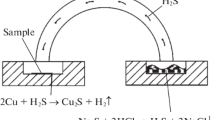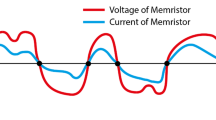Abstract
A new method to realize a discrete memristor is proposed. The device under study consists of a tube filled of aqueous saturated solution of copper sulfate which can be electrolyzed by using two asymmetric copper electrodes, one of which has a considerably smaller cross-sectional area than to the other one. It is shown both theoretically and experimentally that this device has exactly the properties of a memristor if it is designed such that the electrical field and the current density on the thinner electrode when it acts as anode are sufficiently large. Different aspects of the proposed discrete memristor, including pinched hysteresis loop, on-off resistance ratio and memory volatilization, are studied and experimental results are presented.













Similar content being viewed by others
Notes
Note that by applying a sufficiently small positive voltage to the proposed memristor, the resulted electric field will not be strong enough to effectively form new CuO molecules on anode, and consequently, the memristance will not be increased during measurement. But a very accurate tool is needed for measurement of the resulted small electric current in this case.
References
L.O. Chua, The fourth element. Proc. IEEE 100, 1920–1927 (2012)
L.O. Chua, Memristor-the missing circuit element. IEEE Trans. Circuit Theory 18, 507–519 (1971)
D.B. Strukov, G.S. Snider, D.R. Stewart, R.S. Williams, The missing memristor found. Nature 453, 80–83 (2008)
R. Williams, How we found the missing memristor. IEEE Spectr. 45, 28–35 (2008)
G. Gandhi, V. Aggarwal, L.O. Chua, The first radios were made using memristors!. IEEE Circuits Syst. Mag. 13, 8–16 (2013)
Y. Pershin, M. Di Ventra, Practical approach to programmable analog circuit with memristors. IEEE Trans. Circuits Syst. I 57, 1857–1864 (2009)
Y. Pershin, M. Di Ventra, Experimental demonstration of associative memory with memristive neural networks. Neural Netw. 23, 881–886 (2010)
F. Merrikh-Bayat, S.B. Shouraki, F. Merrikh-Bayat, Memristive fuzzy edge detector. J. Real Time Image Process. 9, 479–489 (2014)
S.N. Mirebrahimi, F. Merrikh-Bayat, Programmable discrete-time type I and type II FIR filter design on the memristor crossbar structure. Analog Integr. Circuits Signal 79, 529–541 (2014)
F. Merrikh-Bayat, F. Merrikh-Bayat, S.B. Shouraki, The neuro-fuzzy computing system with the capacity of implementation on a memristor crossbar and optimization-free hardware training. IEEE Trans. Fuzzy Syst. 22, 1272–1287 (2014)
M.D. Pickett, D.B. Strukov, J.L. Borghetti, J. Joshua Yang, G.S. Snider, D.R. Stewart, R. Stanley Williams, Switching dynamics in titanium dioxide memristive devices. J. Appl. Phys. 106, 074508 (2009)
T. Chang, S.-H. Jo, K.-H. Kim, P. Sheridan, S. Gaba, W. Lu, Synaptic behaviors and modeling of a metal oxide memristive device. Appl. Phys. A Mater. 102, 857–863 (2011)
Z.J. Chew, L. Li, A discrete memristor made of ZnO nanowires synthesized on printed circuit board. Mater. Lett. 91, 298–300 (2013)
J.J. Yang, M.X. Zhang, J.P. Strachan, F. Miao, M.D. Pickett, R.D. Kelley, G. Medeiros-Ribeiro, R.S. Williams, High switching endurance in TaOx memristive devices. Appl. Phys. Lett. 97, 232102 (2010)
P.R. Mickel, A.J. Lohn, B.J. Choi, J.J. Yang, M.-X. Zhang, M.J. Marinella, C.D. James, R.S. Williams, A physical model of switching dynamics in tantalum oxide memristive devices. Appl. Phys. Lett. 102, 223502 (2013)
E. Gale, A. Adamatzky, B. de Lacy Costello, On the memristive properties of slime mould. Adv. Phys. Mach. 21, 75–90 (2016)
H.-J. Koo, J.-H. So, M.D. Dickey, O.D. Velev, Towards all-soft matter circuits: prototypes of quasi-liquid devices with memristor characteristics. Adv. Mater. 23, 3559–3564 (2011)
Y.-C. Chen, H.-C. Yu, C.-Y. Huang, W.-L. Chung, S.-L. Wu, Y.-K. Su, Nonvolatile bio-memristor fabricated with egg albumen film. Sci. Rep. 5, Article number: 10022 (2015)
M.D. Reyes Tolosa, J. Orozco-Messana, A.N.C. Lima, R. Camaratta, M. Pascual, M.A. Hernandez-Fenollosa, Electrochemical deposition mechanism for ZnO nanorods: diffusion coefficient and growth models. J. Electrochem. Soc 158(11), E107–E110 (2011)
D. Grujicic, B. Pesic, Electrodeposition of copper: the nucleation mechanisms. Electrochim. Acta 47, 2901–2912 (2002)
G. Hinds, The Electrochemistry of Corrosion (Corrosion Doctors Publications, 1996), pp. 4–5
C. Kok Yew, Express Chemistry Form 4, Pelangi ePublishing Sdn Bhd, Mehr 10, 1391 AP-Education (2012)
A. Rahnama, M. Gharagozlou, Preparation and properties of semiconductor CuO nanoparticles via a simple precipitation method at different reaction temperatures. Opt. Quant. Electron 44, 313–322 (2012)
S. Prasad Adhikari, MPd Sah, H. Kim, L.O. Chua, Three fingerprints of memristor. IEEE T. Circuits I 60, 3008–3021 (2013)
D. Biolek, Z. Biolek, V. Biolkova, Pinched hysteresis loops of ideal memristors, memcapacitors and meminductors must be self-crossing. Electron. Lett. 47, 1385–1387 (2011)
J. Eskhult, Electrochemical Deposition of Nanostructured Metal/Metal Oxide Coatings, Doctoral Dissertation, Acta Universitatis Upsaliensis Uppsala (2007)
H.B. Hassan, Z. Abdel, Hamid, Electrodeposited Cu–CuO composite films for electrochemical detection of glucose. Int. J. Electrochem. Sci. 6, 5741–5758 (2011)
Author information
Authors and Affiliations
Corresponding author
Rights and permissions
About this article
Cite this article
Merrikh-Bayat, F., Parvizi, M. Practical method to make a discrete memristor based on the aqueous solution of copper sulfate. Appl. Phys. A 122, 602 (2016). https://doi.org/10.1007/s00339-016-0132-6
Received:
Accepted:
Published:
DOI: https://doi.org/10.1007/s00339-016-0132-6




